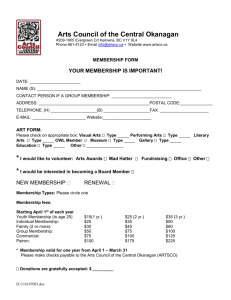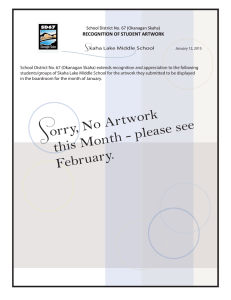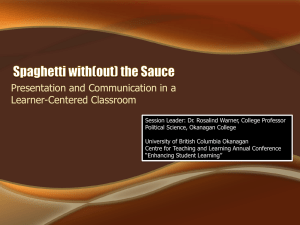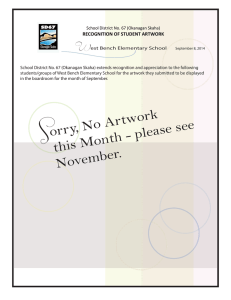Document 14070992
advertisement
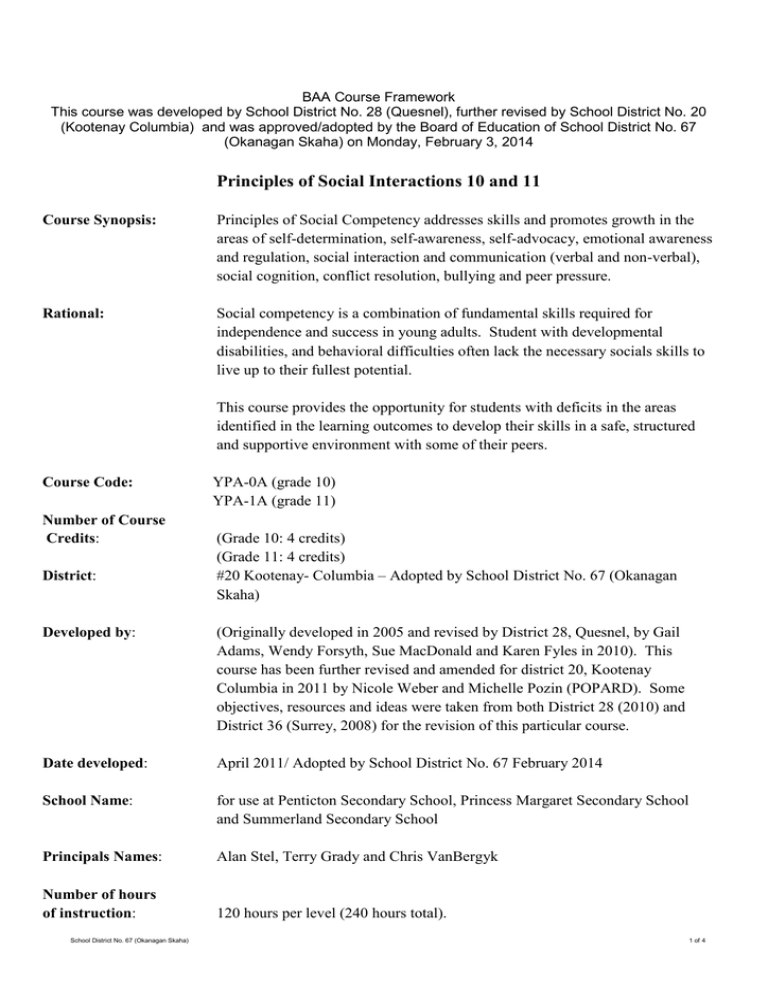
BAA Course Framework This course was developed by School District No. 28 (Quesnel), further revised by School District No. 20 (Kootenay Columbia) and was approved/adopted by the Board of Education of School District No. 67 (Okanagan Skaha) on Monday, February 3, 2014 Principles of Social Interactions 10 and 11 Course Synopsis: Principles of Social Competency addresses skills and promotes growth in the areas of self-determination, self-awareness, self-advocacy, emotional awareness and regulation, social interaction and communication (verbal and non-verbal), social cognition, conflict resolution, bullying and peer pressure. Rational: Social competency is a combination of fundamental skills required for independence and success in young adults. Student with developmental disabilities, and behavioral difficulties often lack the necessary socials skills to live up to their fullest potential. This course provides the opportunity for students with deficits in the areas identified in the learning outcomes to develop their skills in a safe, structured and supportive environment with some of their peers. Course Code: Number of Course Credits: District: YPA-0A (grade 10) YPA-1A (grade 11) (Grade 10: 4 credits) (Grade 11: 4 credits) #20 Kootenay- Columbia – Adopted by School District No. 67 (Okanagan Skaha) Developed by: (Originally developed in 2005 and revised by District 28, Quesnel, by Gail Adams, Wendy Forsyth, Sue MacDonald and Karen Fyles in 2010). This course has been further revised and amended for district 20, Kootenay Columbia in 2011 by Nicole Weber and Michelle Pozin (POPARD). Some objectives, resources and ideas were taken from both District 28 (2010) and District 36 (Surrey, 2008) for the revision of this particular course. Date developed: April 2011/ Adopted by School District No. 67 February 2014 School Name: for use at Penticton Secondary School, Princess Margaret Secondary School and Summerland Secondary School Principals Names: Alan Stel, Terry Grady and Chris VanBergyk Number of hours of instruction: 120 hours per level (240 hours total). School District No. 67 (Okanagan Skaha) 1 of 4 Pre-Requisite(s): Referral by Case Manager, Teacher, Counselor, School Based Team or Parent. Students may also self-refer if appropriate. PSI learning outcomes rating scale as a pre-assessment. (See attached) Special Training, Facilities or Equipment Required: • Resource Teacher and Support Staff with specialized training in Autism Spectrum Disorder and other developmental disabilities including social skill deficits and behavior disorders. • Knowledge of Michelle Garcia Winner’s concepts/strategies in teaching “Social Thinking.” • Digital Camera with video capacity. • TV with VCR/DVD player. • Laptop or PC. • Internet Access (high speed and wireless preferred). • Window’s movie maker and Media Player. • Social skills pre-assessment (PSI rating scale). Board /Authority Approval Date: Board /Authority Approved Signature: Organizational Structure: Grade 10 Unit/ Topic Title Unit 1 Self Determination, Self Awareness, Self Advocacy Unit 2 Emotional Awareness and Regulation Total Time (hrs) 50 70 120 hrs % of Grade 50% 50% 100% Time (hrs) 60 40 20 120 hrs % of Grade 50% 30% 20% 100% Grade 11 Unit/ Topic Unit 1 Unit 2 Unit 3 Total Title Social Interaction and Communication (verbal and non-verbal) Social Cognition (thinking about others thinking) Managing Conflicts and Negative Interactions School District No. 67 (Okanagan Skaha) 2 of 4 Learning Outcomes: Grade 10 Unit 1 : Self Determination, Self Awareness, Self Advocacy The student will: • Recognize and explore his/ her own strengths and talents, values, interests, likes and dislikes. • Learn about the key traits, or characteristics, of individuals with his/ her developmental disability. • Learn how his/ her developmental disability affects the way he/ she learns. • Articulate to others what he/ she needs in different settings, as related to their learning styles and disabilities. • Develop strategies for the initiation and completion of tasks or projects. (Plans, time lines). • Be able to organize leisure time to accommodate his/ her own needs, the needs of others and time constraints. (Homework, agenda usage, daily schedules). • Distinguish between asking for help and the need for clarification. • Recognize when he/ she needs help and develop strategies to obtain this in various settings. (Including school, work place, home-life scenarios.) • Participate in planning his/ her own educational program and Post-Secondary opportunities. Unit 2: Emotional Awareness and Self-Regulation The student will: • Recognize and label a range of emotions in themselves based on thoughts or experiences (ex. Anxiety, anger, surprise, fear, etc). • Identify both appropriate and inappropriate expression of emotions. • Identify his/ her own levels of anger, anxiety or stress. (5 point scale) • Recognize and acknowledge the causes of his/her own anger, anxiety or stress. • Learn that anger and other emotions are natural responses. • Recognize that his/ her own emotional response should match the magnitude of the problem (mountain vs. mole hill). • Develop and practice positive self-management strategies in stressful situations and preparing for stressful situations. (prevention and intervention strategies) • Identify physiological responses to self-management strategies. • Identify healthy emotional outlets outside of the school or work environments. (Stress release). • Demonstrate knowledge of respectful behavior as an expression of their anger. (Ex. Tone, body language and words). School District No. 67 (Okanagan Skaha) 3 of 4 Grade 11 Unit 1: Social Interactions and Communication (verbal and non-verbal) 1a) Non Verbal Communication: The student will: • Identify a variety of means of non-verbal communication. (ex. Eye gaze, tone, gestures, selfinjurious behavior, proximity, facial expressions, volume of voice, speed of voice, physical aggression, crying, posture). • Demonstrate an ability to interpret various body language and facial cues to determine intent or feeling of another person. • Understand and practice the different ways we use our eyes to think, interpret social contexts and read the environment (ex. Showing interest in others, knowing when it’s our turn to speak, gathering information). • Accurately predict what other people are looking at and thinking about based on his/ her own observations. • Understand and practice basic social rules. (ex. Etiquette, manners, politeness, staring vs. eye-contact, physical and emotional boundaries, joint attention, sharing, turn taking, appropriate space, etc). • Develop an understanding of the value of using white lies in necessary situations. • Demonstrate what it means to be mentally or cognitively part of a group. (ex. Active listening- with ears, eyes, brain, mouth, posture and orientation) 1b) Social Communication (in person, email, and phone): The student will: • • • • • • • • • • • • • • Develop strategies to start conversations in various ways. (ex. Ask questions, comment, complimenting). Appropriately join a conversation between two or more people. Learn to make introductions and introduce themselves to others. Practice strategies for maintaining interactions- (showing interest in others opinions/ ideas, questioning, piggy-backing, turn taking, talking on topic, topic transitions). Being aware of non-verbal cues while conversing. Acknowledge and converse about the interests of others. Change the topic of conversation to fit the interests of others. Respond to open ended questions from others with some detail. Give and receive compliments. Give and receive criticism in a constructive, considerate manner. Recognize and understand the meaning of peer jargon and slang. Understand the difference between figurative vs. literal language. (Ex. similes, metaphors, irony and sarcasm). Read cues to terminate a conversation. End a conversation appropriately. School District No. 67 (Okanagan Skaha) 4 of 4 Unit 2: Social Cognition (thinking about others thinking): The student will: • • • • • • • • • • • • Understand the difference between relationships in different contexts. (Ex. A friend or acquaintance in school, neighborhood, community, facebook, MSN, Twitter, My Space). Recognize the value as it relates to themselves of using tolerance and patience towards others who are exhibiting anxiety, anger or some level of discomfort. Demonstrate knowledge of empathy and when to use it appropriately. Distinguish between appropriate topics, behaviors and places for private vs. public communications. (Social expectations are contextual). Understand that he/ she can have a positive or negative impact on the perception others have of him/ her. Understand that the way he/ she is perceived by others is based on a collection of events stored in that person’s memory. Recognize the impact of his/ her own facial expression, body language, and tone of voice to others. Adjust his/ her own behavior based on the reaction of others. Adjust his/ her own behavior to keep others thinking about him/ her in the way he/ she would like. Learn how to recognize and fix a social blunder or faux pas. Consider multiple points of view and acknowledge the opinions of others. Deduce the intentions, motives and desires of others in various contexts, including the digital world. Unit 3: Managing conflicts and negative interactions 3a) Conflict Resolution: The student will: • • • • • • • Identify settings, people and events that potentially cause conflict for themselves. Identify attributes or behaviors in others that cause them anxiety. Learn about compromise and his/ her own role in the development and resolution of problems with others. Identify ways to solve issues during a conflict (ex. Negotiation, compromise, turn taking, “I messages”, asking others to change their behavior). Learn strategies to conclude a conflict or disagreement (ex. Self-talk, visualization). Discern when to access help. Recognizing when it is appropriate and not appropriate to be involved in others conflicts. 3b) Bullying and Peer Pressure: The student will: • • • • • • Define behaviors associated with bullying. Identify situations when bullying has occurred. Distinguish between bullying and peer pressure behavior. Recognize positive and negative relationships based on associated behavior. Develop strategies to effectively manage bullying behavior. Demonstrate knowledge showing how to deal with peer pressure effectively and respectfully. School District No. 67 (Okanagan Skaha) 5 of 4 • Demonstrate knowledge of how to terminate negative relationships involving bullying. Instructional Component: o o o o o o o o o o o o o o o o o o o o o o Direct Instruction Brainstorming Small group work Volunteer opportunities to practice skills Discussion Novel studies to assess character traits/ skills Fiction and non-fiction short stories Role playing Games Video modeling Peer/ teacher modeling Peer tutor support Social autopsies Video self-modeling Social Stories tm Comic Strip conversations tm Graphic organizers Student handouts Interviews Self analysis- projects Informal observation ABC functional behavior charting Assessment Component: Progress towards IEP goals, as reflected through the following methods: o Self reflection and evaluation o Peer evaluation o Group discussion and active involvement o Data collection (PSC rating scale inventory pre and post) o Peer interviews o Course activities o Weekly journals o Student handouts o Tests and quizzes o Cumulative projects o Power point projects- self advocacy/ self awareness o Rubrics (created collaboratively between students and teacher) Learning Resources: Books: o Gray, Carol. The New Social Story Book. Arlington, TX: Future Horizons, 2010. Print. o Begun, Ruth Weltmann. Ready-to-use Social Skills Lessons & Activities for Grades 7-12. West Nyack, NY: Center for Applied Research in Education, 1996. Print. o Bowen, Julie M. The Tough Kid Bully Blockers Book: 15-minute Lessons for Preventing and Reducing Bullying. Eugene, OR: Pacific Northwest, 2008. Print. o Buron, Kari Dunn., and Mitzi Curtis. The Incredible 5-point Scale: Assisting Students with Autism Spectrum Disorders in Understanding Social Interactions and Controlling Their Emotional Responses. Shawnee Mission, KS: Autism Asperger Pub., 2003. Print. o Buron, Kari Dunn. A 5 Is against the Law!: Social Boundaries : Straight Up! :. Shawnee Mission, Kan.: Autism Asperger Pub., 2007. Print. School District No. 67 (Okanagan Skaha) 6 of 4 o Winner, Michelle Garcia. Worksheets for Teaching Social Thinking and Related Skills: Breaking down Concepts for Teaching Students with Social Cognitive Deficits. San Jose, CA: Think Social, 2005. Print. o Winner, Michelle Garcia. Thinking about You, Thinking about Me. San Jose, CA: Think Social, 2007. Print. o Kellner, Millicent H. In Control: a Skill-building Program for Teaching Young Adolescents to Manage Anger. Champaign, IL: Research, 2004. Print. o McAfee, Jeanette L. Navigating the Social World: a Curriculum for Individuals with Asperger's Syndrome, High Functioning Autism and Related Disorders. Arlington, TX: Future Horizons, 2002. Print. o Faherty, Catherine, and Gary B. Mesibov. Asperger's... What Does It Mean to Me?: a Workbook Explaining Self Awareness and Life Lessons to the Child or Youth with High Functioning Autism or Aspergers, Structured Teaching Ideas for Home and School. Arlington, TX: Future Horizons, 2006. Print. o Gray, Carol. Comic Strip Conversations: Colorful, Illustrated Interactions with Students with Autism and Related Disorders. Jenison, MI: Jenison Public Schools, 1994. Print. o LoGiudice, Carolyn, and Paul F. Johnson. Spotlight on Social Skills, Adolescent. East Moline, IL: LinguiSystems, 2008. Print. o Mannix, Darlene. Social Skills Activities for Secondary Students with Special Needs. San Francisco, CA: Jossey-Bass, 2009. Print. o Winner, Michelle Garcia. Think Social!: a Social Thinking Curriculum for School-age Students : for Teaching Social Thinking and Related Social Skills to Students with High Funtioning Autism, Asperger Syndrome, PDD-NOS, ADHD, Nonverbal Learning Disability and for All Others in the Murky Gray Area of Social Thinking. San Jose, CA: Michelle Garcia Winner, 2008. Print. o Baker, Michael O. What Would You Do?: Moral Dilemmas. Seaside, CA: Critical Thinking, 2008. Print. Web Resources: o o o o o http://glennrowe.net/BaronCohen/Faces/EyesTest.aspx http://www.actcommunity.net/ http://www.autismoutreach.ca/ http://www.makebeliefscomix/Comix/ http://www.socialthinking.com Other: o Various board games o Social skills games (ex. Chicken soup for the kid’s soul) o Winner, M. G. (2005) Strategies for Organziation: Preparing for Homework and the Real World. Kentwood, MI. The Gray Center for Social Learning and Understanding. o LoGiudice, C. et al. No-glamour social language/ behavior cards. LinguiSystems. o The Best of Mr. Bean. (2006). Tiger Aspect Productions Ltd. A&E Television Networks. o The Big Bang Theory videos. o Social Language Development Scenes for Adolescents. (2011) LinguiSystems. School District No. 67 (Okanagan Skaha) 7 of 4 School District No. 67 (Okanagan Skaha) 425 Jermyn Ave. Penticton, BC V2A 1Z4 Ph: 250-770-7700 Fax: 250-770-7730 PSI Learning Outcomes Rating Scale Student's Name: Age: Years Gender: Birth Date: M F / Month / Day Year Grade: School: Case Manager: Rater's Name(s): The PSI Learning Outcomes Rating Scale is designed as a companion to the School District No. 67 (Okanagan Skaha) Support Services Board Authority Authorized course: Principles of Social Interaction (PSI). Each of the skills listed corresponds to a Learning Outcome outlined in the PSI Course. This document is intended as both a pre and post assessment for students enrolled in PSI. The results from the assessment are used to determine appropriate student groupings as well as to establish a focus for the subsequent semester of instruction. This assessment is not designed to provide diagnostic information, nor is it a norm- referenced tool. Individuals or student teams completing the PSI Learning Outcomes Rating Scale should rate the student's performance according to the following descriptors: N = S = O = F = NO = Never Sometimes Often Frequently or Always Not Observed School District No. 67 (Okanagan Skaha) 1 of 4 Unit 1 N = Never S = Sometimes O = Often F = Frequently or Always NO = Not Observed Self Determination, Self Awareness and Self Advocacy The student: 1 recognizes his/her own strengths and talents, interests, likes and dislikes 2 possesses knowledge of the key traits, or characteristics, of individuals with his/her developmental disability 3 understands how his/her developmental disability affects the way he/she learns 4 understands how his/her developmental disability impacts the sensory system and the way he/she experiences the environment 5 shares information about his/her disability and needs with others 6 articulates to others what he/she needs in different settings 7 participates in planning his/her own educational program and post secondary opportunities 8 is able to organize leisure time to accommodate his/her own needs, the needs of others and time constraints 9 exhibits awareness of his/her own thinking or meta-cognitive processes 10 applies strategies for the initiation and completion of tasks or projects 11 applies strategies for problem solving and generating alternatives N S O F NO N S O F NO sub-total Unit 2 Emotional Functioning, Behaviour, and Conflict Resolution The student: 12 is able to identify his/her own levels of anger, anxiety, and/or stress 13 applies strategies to manage anger, anxiety, and/or stress (e.g., relaxation, selfmonitoring) 14 recognizes and acknowledges the causes of his/her own anger, anxiety and/or stress 15 matches his/her emotional response to the magnitude of the problem 16 recognizes that in certain environments (e.g., school, work, community) a compressed emotional reaction is expected 17 enjoys healthy emotional outlets outside of the school or work environment 18 compromises during disagreements with others 19 demonstrates flexible thinking in response to change 20 expresses how he/she is feeling either verbally or in written form 21 is able to name someone who can help with problems 22 identifies, discusses and resolves problems 23 acknowledges his/her own role in the development and resolution of problems 24 responds appropriately to a bullying attempt, including cyberbullying 25 knows how to report a bullying attempt, including cyberbullying 26 recognizes when his/her own behaviour could be interpreted as bullying, including cyberbullying sub-total School District No. 67 (Okanagan Skaha) 2 of 4 Unit 3 N = Never S = Sometimes O = Often F = Frequently or Always NO = Not Observed Social Interactions and Communication Nonverbal Communication The student: 27 recognizes complex emotions in others and self (e.g., frustrated, overwhelmed, embarrassed) 28 interprets the facial expressions of others (e.g., level of interest, disbelief) 29 interprets the body language of others (e.g., friendly, open, closed, aggressive) 30 interprets the tone of voice of others (e.g., sarcasm, anger, excitement) 31 maintains appropriate personal space when interacting with others 32 understands the different ways we use our eyes to think, interpret social contexts, and read the environment (e.g., to show interest in others, to know when it is our turn to speak, to gather information) 33 predicts what other people are looking at and thinking about based on his/her own observations 34 demonstrates being part of a group through his/her own body language 35 demonstrates what it means to be mentally or cognitively part of a group 36 demonstrates the concept of active listening (i.e., listening using the ears, eyes, brain, mouth, body posture and orientation N S O F NO N S O F NO sub-total Social Interactions and Communication Social Communication The student: 37 makes introductions 38 introduces self to others 39 gives and receives compliments 40 asks questions to request information about a person 41 asks questions to request information about a topic 42 asks for assistance with tasks 43 recognizes and understands the meaning of peer jargon 44 initiates an interaction or conversation with others 45 appropriately joins a conversation between two or more people 46 responds to the open ended questions of others with some detail 47 maintains interactions and conversations (e.g., turn taking, talking on topic, topic transitions, interjections) 48 acknowledges and converses about the interests of others 49 changes the topic of conversation to fit the interests of others 50 speaks using an appropriate tone of voice 51 appropriately asks others to change their behaviour 52 reads cues to terminate a conversation 53 ends a conversation appropriately sub-total School District No. 67 (Okanagan Skaha) 3 of 4 N = Never S = Sometimes O = Often F = Frequently or Always NO = Not Observed Social Interactions and Communication Social Cognition The student: N 54 expresses or demonstrates sympathy for others 55 empathizes with and shows insight into the feelings of others 56 deduces the intentions, motives, and desires of others in various contexts, including the digital world (e.g., sincere and insincere comments and requests) 57 considers multiple points of view and acknowledge the opinions of others 58 understands the difference between literal versus figurative language (similes, metaphors, sarcasm and irony) 59 understands the jokes or humour of others S O F NO 60 learns to show interest in what others find interesting, despite his/her own limited interest 61 recognizes the impact of his/her own facial expression, body language and tone of voice on others 63 uses appropriate facial expression, body language and tone of voice based on the setting or context 62 learns how to fix a social blunder 64 distinguishes appropriate topics, activities and places for private versus public social communications 65 adjusts language to varying social situations (i.e., social register) 66 understands that there are different social norms, or behaviours, expected for different social settings (i.e., social expectations are contextual) 67 understands that he/she can have a positive or negative impact on the perception others have of him/her 68 understands that the way he/she is perceived by others is based on a collection of events stored in that person's memory 69 understands the link between behaviour, emotions, thoughts and the environment 70 modifies his/her own behaviour based on the reactions of others 71 modifies his/her own behaviour to keep others thinking about him/her in the way he/she would like 72 understands the difference between an acquaintance and a friend in different contexts (e.g., school neighbourhood, community, Facebook, MSN, Twitter, My Space) 73 understands the development and impact of his/her digital footprint sub-total Additional Information: School District No. 67 (Okanagan Skaha) 4 of 4
